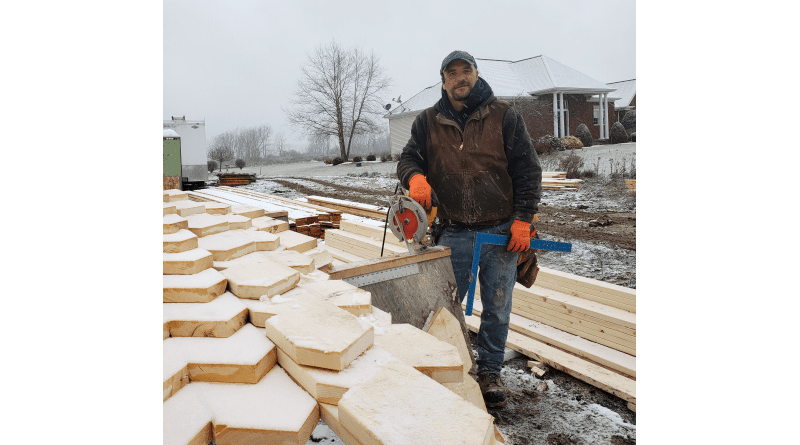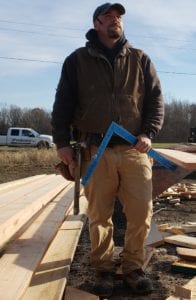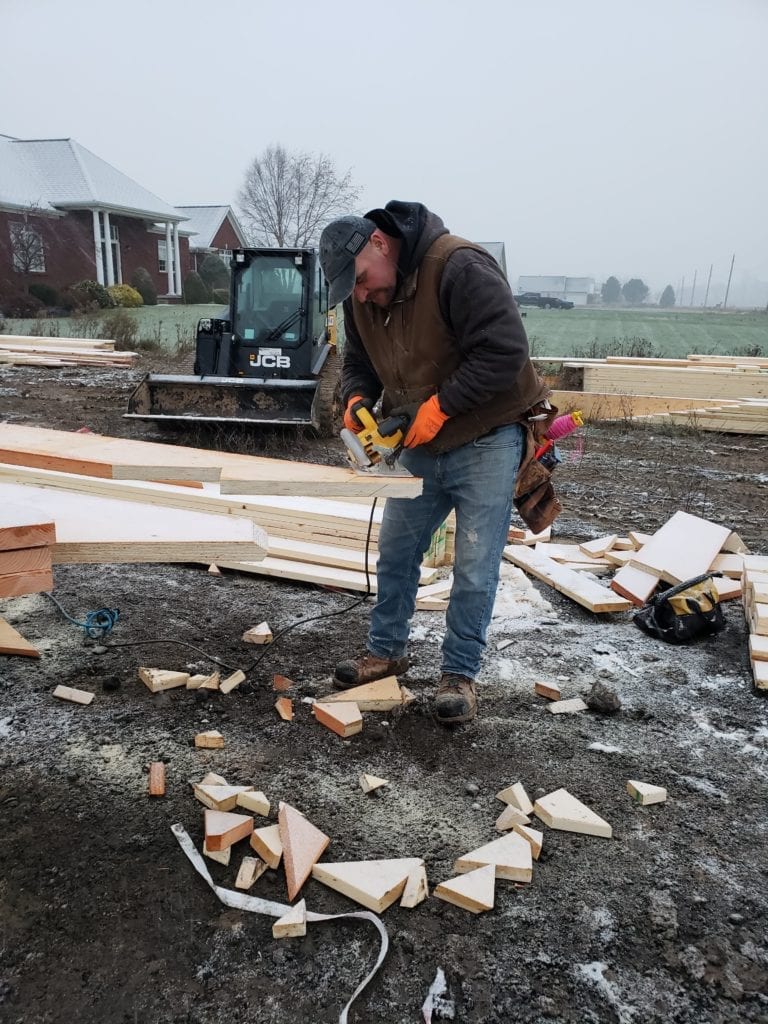Meet the Member – Ryan Smith of Niagara, N.Y.
We are lucky enough to have group members from all over the world in the Builders’ Talk Group Community!! Here we hear from Ryan Smith – an American framing carpenter who told us something about what he does!
Hi Ryan, tell us a little bit about yourself!
My name is Ryan Smith, I am 37 years old and have been a framing carpenter for the last 19 years. I specialise in roof cutting and framing in the crews I work with.
I am currently employed by a small company of about 12 employees. We have 2 crews which we run year-round framing homes. I have been here for the last 6 years, before that I worked for various other framing companies and even ran my own business for 5 years. I went employed when the industry dried up here, after the recession which hit the whole country. That, along with the young family I had at home with my wife were good enough reasons for me to hang it up and work for someone else. Missing so many moments in their young lives wasn’t worth the aggravation I was faced with back then. I am very happy with my position in the company I work for and carry a lot less stress now than the ownership side running a business and all the work involved with that.
How did you get started?
I started my career at the age of 18 right out of high school. I went to work for the father of a good friend, who had a small construction company in my hometown of Oswego N.Y. That’s where I learned the basics of home building. I then attended college at the local university and met my wife there. She graduated in 2000 and wanted to move back home a year later. She’s from the Niagara region of Western New York and I soon followed. I never finished my college education as the building industry had really grasped my interest, I very quickly became passionate about and consumed by it.
Where are you based?
Where I live now, in Niagara county near the Buffalo region of New York state, the demand for custom built homes is very high. The problem we are faced with here isn’t the amount of work out there, it’s the lack of younger generations coming into the trades to learn our craft. The crew I work on is comprised mainly of 32-45 year old carpenters, many who have been working in the trade for many years and several who haven’t much experience. We do have a few younger men on the crews in their early 20’s. I wish we had more! There isn’t really anyone to pass the knowledge onto. The younger generations here are different than when I was coming up through the trade learning from the older guys. They have a different work ethic than we did. I’m sure that’s the shot heard around the world ha-ha. When I started framing every job-site was full of young men and women learning the trade. I feel like a dinosaur at the young age of 37, it’s sad really to see the trades suffering from the lack of motivated interested people to carry on the trades.
Who do you work/contract for?
We work for many different builders and private home owners. Builders, as they are known here, buy or own the land and have the blue prints made to suit the customer’s needs. They basically just organise all the subcontracting tradesman to complete all the necessary work to take the build from start to finish. 99% of the builders here do not actually complete any of the work on the home. The privates, as we call them, are the person/homeowner wishing to build a house and take care of all the organising and hiring the different trades. I personally don’t have a preference on which we work for although the jobs run through the builders are often smoother due to their experience with the home building process.
How has your trade progressed since you began?
Since I have been wearing a tool-belt I have seen many changes in the industry. Materials and products used as well as the techniques and tools used on the job have all had their changes. I would say the biggest change I have seen on the job would deal with the daily production. We now use machines on every job such as forklifts, lulls or boom lifts. They are commonplace nowadays. Almost every framing crew here has them on site for every job. Many rent them from local rental outfits and many own their own. We have 4 that we own and move around to our jobs depending on where they are needed most. They have made the productivity of a custom framing job so much faster, the moving of material around and lifting heavy walls etc. has really sped things up! The quality of the tools we use now is much better as well as being much lighter also aiding in the daily productivity. The days of hand nailing a house together are a thing of the past.
What do you do to keep up with the times/industry changes?
Pre-made panel houses or prefabbed homes are making their way into the industry here. I personally despise them and the whole idea of the pre-made system. I feel that this very idea of prefabbing homes has really affected the quality and knowledge of modern-day framing carpenters. The company I work for simply will not bid on these types of jobs as we are geared for the custom built home. Meaning hand framed floors and walls and of course the hand cut roof rafter systems. We are faster at stick framing a roof than we are setting trusses. Pre-manufactured roof trusses and walls have really hurt the trade as stated above, that’s just my opinion! I have met and know many carpenters with years of experience who cannot figure a simple common rafter or stair stringers even.
I am solely responsible for roof cutting on the crews. I cut for 2 crews year-round, following from one job to the next. The roof has always been my favourite part of the build ever since I started walking on to job sites. As a younger carpenter I would always look out to the sawhorses and watch in awe the lead carpenter cutting the roof rafters and how they would fit perfectly together way up in the air above the house we had framed below. I became obsessed with the roof and wanted to learn how to go about doing it. It was confusing though, when I started. So I spent many hours on and off the job learning the methods I needed to build the roof – playing around with small scale mock ups I would build after work or at home to figure things out. It would have been a lot easier today with the internet and so many good books around. I have since spent many years learning about rafters and cutting them. Figuring the length of common rafters, hips and valley rafters is common for many in the industry worldwide. However, many never took it any further than that and still “AIR” measure the remaining pieces.
I have developed my own style or technique to finding all the angles and calculating all the pieces of the roof system using simple plan view drawings of different areas of the roof to help the calculating of the rafters. Hip jack rafters to wall, hip to valley jacks ridge to valley, broken hips or flyers to valleys or walls and anything In between. I begin cutting as soon as the floor system is completely framed. With the floor complete I can then measure all the exterior walls and all the spans on the floor and begin figuring all the different parts of the roof. It took me years to realise I could cut the roof in its entirety with just knowing the dimensions of the house. Now I cut every piece while the boys are building the walls and ceiling of the house like a big puzzle. Most of the roof structures on the houses here where I build are irregular pitched hip roofs or “Bastards” as commonly referred to in the industry here. I am very fortunate and grateful for the complex roofs we get to build here on most of the homes we frame. The constant challenge has really helped me think outside the box and build my skillset.
What has been your best buy tool wise?
This one is easy. My framing squares are my most used tools and I would be lost without them, I own quite a few and use them every single day. Having a good saw with a nice square table and good sharp blades is also very important to me, oh yes and lots and lots of pencils ha-ha.
What advice would you give to anyone starting out in the industry?
If I could give any advice to the younger generations coming into the trade it would be this:
Decide quickly if you like and really enjoy the work, it’s not for everyone. If you do, then be open to the teachings and criticisms of the older carpenters you are working with. DON’T take anything personally, remember as much as you can, write it down in a notebook if it helps you. The skills and techniques your mentors share with you are equivalent to a college education. It took them years to develop and master their trade! Remember if they are teaching you then they love the trade and most likely have for many years. Always respect our trade, it’s an honourable, honest career that can be extremely rewarding if you enjoy what you do every day. Don’t treat it like it’s just your job, take pride in what you do. If you want to be a lead on a job or run your own crew someday, they will need a good leader to follow. BE THAT LEADER! Show your pride and passion for your work in all that you build even when no one will see it or is watching. Know that it may take years to gain the confidence needed to fully understand the trade. STICK WITH IT. You will never work a day in your life if you love what you do. Always be learning and thinking of ways to be more efficient or more accurate in your work etc. I am still learning every day and still get intimate with each build I am on!
Seems like Ryan has a real passion for what he does, the skill he uses in the roof framing he works on is that of a true craftsman, it’s interesting to see how construction differs in other countries, we don’t see so many builds like this in the UK! If you want to read more about your fellow wood gods, have a look at this next article!



